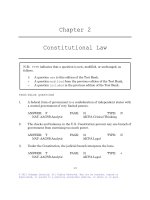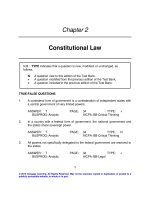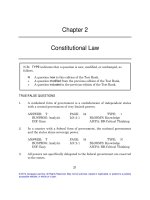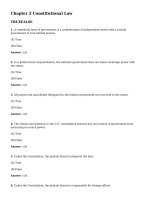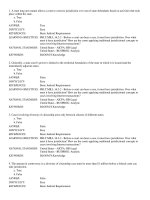Bus law today 9th ed ch20
Bạn đang xem bản rút gọn của tài liệu. Xem và tải ngay bản đầy đủ của tài liệu tại đây (352.68 KB, 68 trang )
BUSINESS LAW TODAY
Essentials 9th Ed.
Roger LeRoy Miller - Institute for University Studies, Arlington, Texas
Gaylord A. Jentz - University of Texas at Austin, Emeritus
Chapter
20
Corporations
© 2011 Cengage Learning. All Rights Reserved. May not be copied, scanned, or duplicated, in whole or in part, except for use as permitted in
a license distributed with a certain product or service or otherwise on a password-protected website for classroom use.
1
Learning Objectives
What steps are involved in bringing a
corporation into existence?
In what circumstances might a court
disregard the corporate entity (“pierce the
veil”) and hold shareholders personally
liable?
What are the duties of corporate directors and
officers?
What is a voting proxy? What is cumulative
voting?
What are the differences between a merger, a
consolidation, and a share exchange?
© 2011 Cengage Learning. All Rights Reserved. May not be copied, scanned, or duplicated, in whole or in part, except for use as permitted in
a license distributed with a certain product or service or otherwise on a password-protected website for classroom use.
2
The Nature of the Corporation
A corporation is a legal entity, a
creature of statute, an artificial
“person.”
Most states follow the Model Business
Corporation Act (MBCA) or the RMBCA, that
are model corporation laws.
The shares (stock) of a corporation are
owned by at least one shareholder
(stockholder).
© 2011 Cengage Learning. All Rights Reserved. May not be copied, scanned, or duplicated, in whole or in part, except for use as permitted in
a license distributed with a certain product or service or otherwise on a password-protected website for classroom use.
3
Corporate Personnel
Board of Directors: manage the big
picture, set policy, hire officers.
Officers: manage the day-to-day
operations of the corporation.
© 2011 Cengage Learning. All Rights Reserved. May not be copied, scanned, or duplicated, in whole or in part, except for use as permitted in
a license distributed with a certain product or service or otherwise on a password-protected website for classroom use.
4
Constitutional Rights of
Corporations
A corporation is an artificial “person”
and has constitutional rights to:
Equal protection;
Access to the courts, can sue and be sued;
Right to due process before denial of life,
liability or property.
© 2011 Cengage Learning. All Rights Reserved. May not be copied, scanned, or duplicated, in whole or in part, except for use as permitted in
a license distributed with a certain product or service or otherwise on a password-protected website for classroom use.
5
Constitutional Rights of
Corporations
Corporation’s rights (cont’d):
Freedom from unreasonable search and seizure
and double jeopardy.
Freedom of speech.
• Only officers and directors have protection against
self-incrimination.
However, corporations do not have full
protection of privileges and immunities clause.
© 2011 Cengage Learning. All Rights Reserved. May not be copied, scanned, or duplicated, in whole or in part, except for use as permitted in
a license distributed with a certain product or service or otherwise on a password-protected website for classroom use.
6
Limited Liability of
Shareholders
The corporation provides limited
liability for stockholders.
In certain situations, the corporate
“veil” of limited liability can be
pierced, holding the shareholders
personally liable.
© 2011 Cengage Learning. All Rights Reserved. May not be copied, scanned, or duplicated, in whole or in part, except for use as permitted in
a license distributed with a certain product or service or otherwise on a password-protected website for classroom use.
7
Corporate Earnings and
Taxation
Corporate profits can either be kept as retained
earnings or passed on to the shareholders as
dividends.
Corporate profits are taxed under federal and
state law as a separate “person” from its
shareholders.
Taxation: Regular “C” corporations are taxed
twice: at the corporate level and at the
shareholder level.
Holding Companies: used to defer U.S. income
taxes (hold shares of another).
© 2011 Cengage Learning. All Rights Reserved. May not be copied, scanned, or duplicated, in whole or in part, except for use as permitted in
a license distributed with a certain product or service or otherwise on a password-protected website for classroom use.
8
Torts and Criminal Acts
A corporation is liable for the torts
committed by its agents or officers
within the course and scope of their
employment under the doctrine of
respondeat superior.
Corporation can be liable for criminal
acts, but only fined. Responsible
officers may go to prison.
© 2011 Cengage Learning. All Rights Reserved. May not be copied, scanned, or duplicated, in whole or in part, except for use as permitted in
a license distributed with a certain product or service or otherwise on a password-protected website for classroom use.
9
Classification of Corporations
Domestic corporation does business in
its state of incorporation.
Foreign corporation from X state doing
business in Z state.
Alien Corporation: formed in another
country doing business in United States.
© 2011 Cengage Learning. All Rights Reserved. May not be copied, scanned, or duplicated, in whole or in part, except for use as permitted in
a license distributed with a certain product or service or otherwise on a password-protected website for classroom use.
10
Classification of Corporations
Public and Private.
Nonprofit.
Close Corporations.
Shares held by family members or very few
shareholders. Management is information, similar to a
partnership.
Transfer of shares is restricted.
Misappropriation of Funds is a major issue.
CASE 20.1 Williams v. Stanford. (2008). Two
minority shareholders prevented one 70% shareholder
from transferring of corporate assets after proving
abuse and fraud.
© 2011 Cengage Learning. All Rights Reserved. May not be copied, scanned, or duplicated, in whole or in part, except for use as permitted in
a license distributed with a certain product or service or otherwise on a password-protected website for classroom use.
11
Classification of Corporations
“S Corporations”: Avoids the federal
“double taxation” of regular corporations at
the corporate level. Only dividends are taxed
to the shareholders as personal income. IRS
requirements:
Corporation is domestic, fewer than 75 shareholders,
only one class of stock, no shareholder can be a nonresident alien.
Professional Corporations.
© 2011 Cengage Learning. All Rights Reserved. May not be copied, scanned, or duplicated, in whole or in part, except for use as permitted in
a license distributed with a certain product or service or otherwise on a password-protected website for classroom use.
12
Corporate Formation and
Powers
The process of incorporation
generally involves two steps:
Promotional Activities; and
The Legal Process of Incorporation.
© 2011 Cengage Learning. All Rights Reserved. May not be copied, scanned, or duplicated, in whole or in part, except for use as permitted in
a license distributed with a certain product or service or otherwise on a password-protected website for classroom use.
13
Incorporation Procedures
Promotio
n
File Articles of
Incorporation
Name
Search
State
Charter
© 2011 Cengage Learning. All Rights Reserved. May not be copied, scanned, or duplicated, in whole or in part, except for use as permitted in
a license distributed with a certain product or service or otherwise on a password-protected website for classroom use.
Subscriber
s
1st Organizational Meeting
14
Selecting the State
State Chartering: Select state (some
states such as Delaware cater to
corporations).
Articles of Incorporation: primary enabling
document filed with the Secretary of State that
includes basic information about the
corporation.
Person(s) who execute the articles are the
incorporators (and maybe the promoters).
© 2011 Cengage Learning. All Rights Reserved. May not be copied, scanned, or duplicated, in whole or in part, except for use as permitted in
a license distributed with a certain product or service or otherwise on a password-protected website for classroom use.
15
Securing the Corporate Name
Choose and reserve a Corporate Name.
Name must have the proper suffix:
“corporation,” “corp.,” “Incorporated.”
You should also consider registering the
corporation as a “dot com” at
networksolutions.com or register.com.
© 2011 Cengage Learning. All Rights Reserved. May not be copied, scanned, or duplicated, in whole or in part, except for use as permitted in
a license distributed with a certain product or service or otherwise on a password-protected website for classroom use.
16
Preparing the Articles of
Incorporation
Purpose: trend towards “any legal
business.”
Duration: usually perpetual.
Capital Structure: Most states requires
some minimal capitalization (Texas
requires $1,000), plus number and
class(es) of shares authorized and
“par value” of shares at incorporation.
© 2011 Cengage Learning. All Rights Reserved. May not be copied, scanned, or duplicated, in whole or in part, except for use as permitted in
a license distributed with a certain product or service or otherwise on a password-protected website for classroom use.
17
Preparing the Articles of
Incorporation
Internal Organization: usually included in
the bylaws.
Registered Office and Agent: specific
person that will receive any legal notice
and documents from state and/or 3rd
parties.
Incorporators (usually the promoter): at
least one with name and address.
© 2011 Cengage Learning. All Rights Reserved. May not be copied, scanned, or duplicated, in whole or in part, except for use as permitted in
a license distributed with a certain product or service or otherwise on a password-protected website for classroom use.
18
Corporate Powers
The express powers of a corporation
are found in the corporation’s articles
of incorporation, the laws of the state
of incorporation, and in the state and
federal corporations.
Corporate by-laws may also grant or
limit a corporation’s express powers.
© 2011 Cengage Learning. All Rights Reserved. May not be copied, scanned, or duplicated, in whole or in part, except for use as permitted in
a license distributed with a certain product or service or otherwise on a password-protected website for classroom use.
19
Corporate Powers
Corporation has implied powers to: to
perform all acts reasonably necessary
to accomplish its corporate purposes,
e.g.,:
•
•
•
Borrow and lend money.
Extend credit.
Make charitable contributions.
A corporate officer can bind corporation in
contract in matters connected with the
ordinary business affairs of the enterprise.
© 2011 Cengage Learning. All Rights Reserved. May not be copied, scanned, or duplicated, in whole or in part, except for use as permitted in
a license distributed with a certain product or service or otherwise on a password-protected website for classroom use.
20
Corporation by Estoppel
Corporation By Estoppel: if it acts like
a corporation, cannot avoid liability by
claiming that no corporation exists.
CASE 20.2 Brown v. W.P. Media, Inc.
(2009). Firm that represented itself as a
corporate entity is estopped from denying
liability for breach of contract even if it was
did not exist at the time of the contract.
© 2011 Cengage Learning. All Rights Reserved. May not be copied, scanned, or duplicated, in whole or in part, except for use as permitted in
a license distributed with a certain product or service or otherwise on a password-protected website for classroom use.
21
Piercing the Corporate Veil
“Piercing the Corporate Veil” occurs when
a court, in the interest of justice or
fairness,” holds shareholders personally
liable for corporate acts.
Court concludes that shareholders used
corporation as a “shield” from illegal
activity.
Factors a court considers:
3rd party tricked into dealing with a
corporation rather than the individual.
© 2011 Cengage Learning. All Rights Reserved. May not be copied, scanned, or duplicated, in whole or in part, except for use as permitted in
a license distributed with a certain product or service or otherwise on a password-protected website for classroom use.
22
Issues: Piercing the Corporate
Veil
Was corporation set up to not make a profit,
remain insolvent, or be under capitalized?
Were statutory formalities followed?
Was the corporation an “alter ego” of a
majority shareholder, with personal and
corporate interests commingled such that
the corporation has no separate identity?
© 2011 Cengage Learning. All Rights Reserved. May not be copied, scanned, or duplicated, in whole or in part, except for use as permitted in
a license distributed with a certain product or service or otherwise on a password-protected website for classroom use.
23
Corporate Financing
Bonds
vs.
Stocks
Debt
Ownership/equity
Fixed ROI
Dividends (variable)
No votes
Vote for Management
Optional
Required
Priority over stock
Paid last
© 2011 Cengage Learning. All Rights Reserved. May not be copied, scanned, or duplicated, in whole or in part, except for use as permitted in
a license distributed with a certain product or service or otherwise on a password-protected website for classroom use.
24
Bonds
Type
Definition
Debentures
No specific corporate assets are pledged as
collateral. Backed by corporation’s general
credit rating.
Mortgages
Pledge specific real estate. If corporation
defaults, bondholders can foreclose.
Convertible
Conditions trigger bonds to convert to
corporate stock.
Callable
Can be “called in” by principal and repaid
according to bond conditions.
© 2011 Cengage Learning. All Rights Reserved. May not be copied, scanned, or duplicated, in whole or in part, except for use as permitted in
a license distributed with a certain product or service or otherwise on a password-protected website for classroom use.
25




